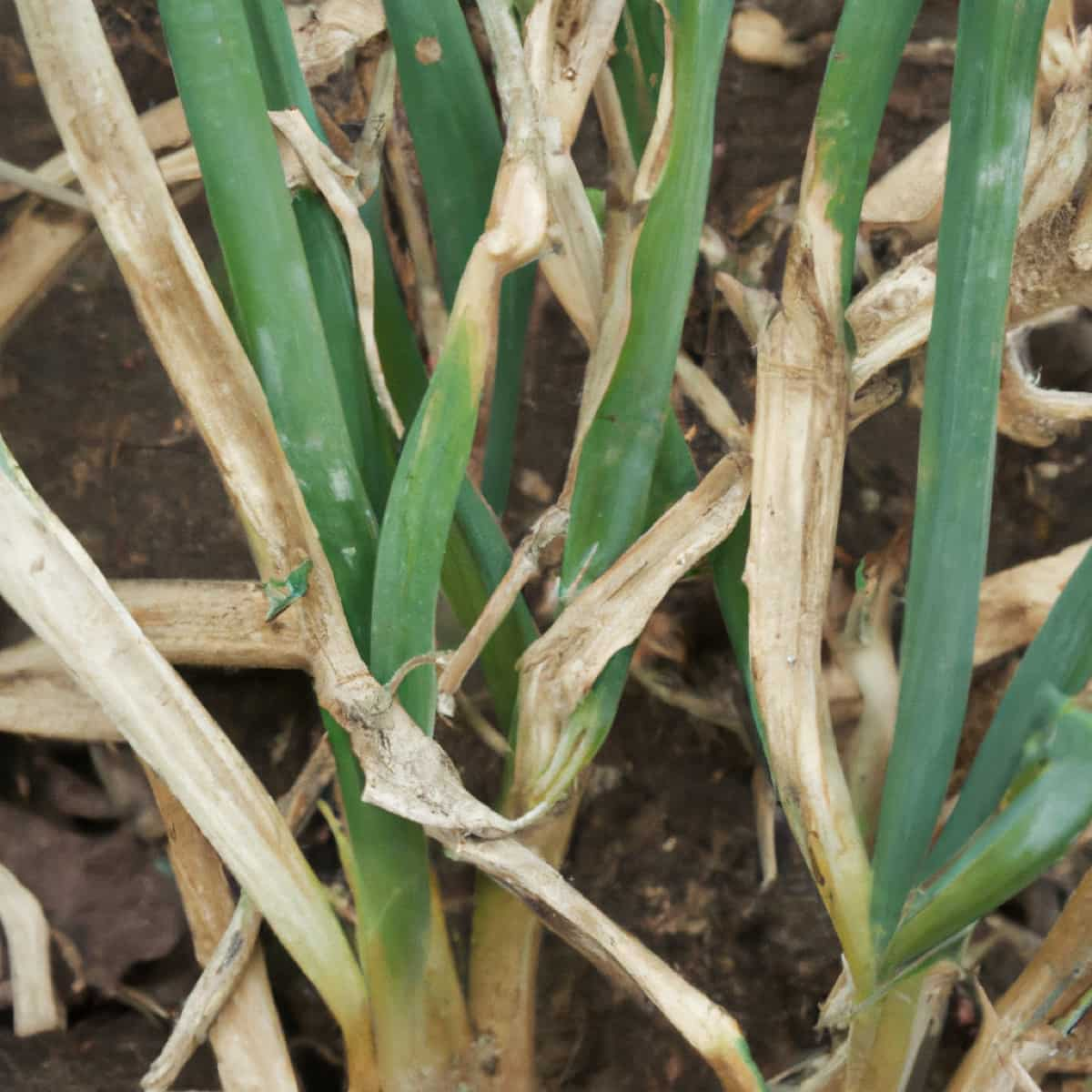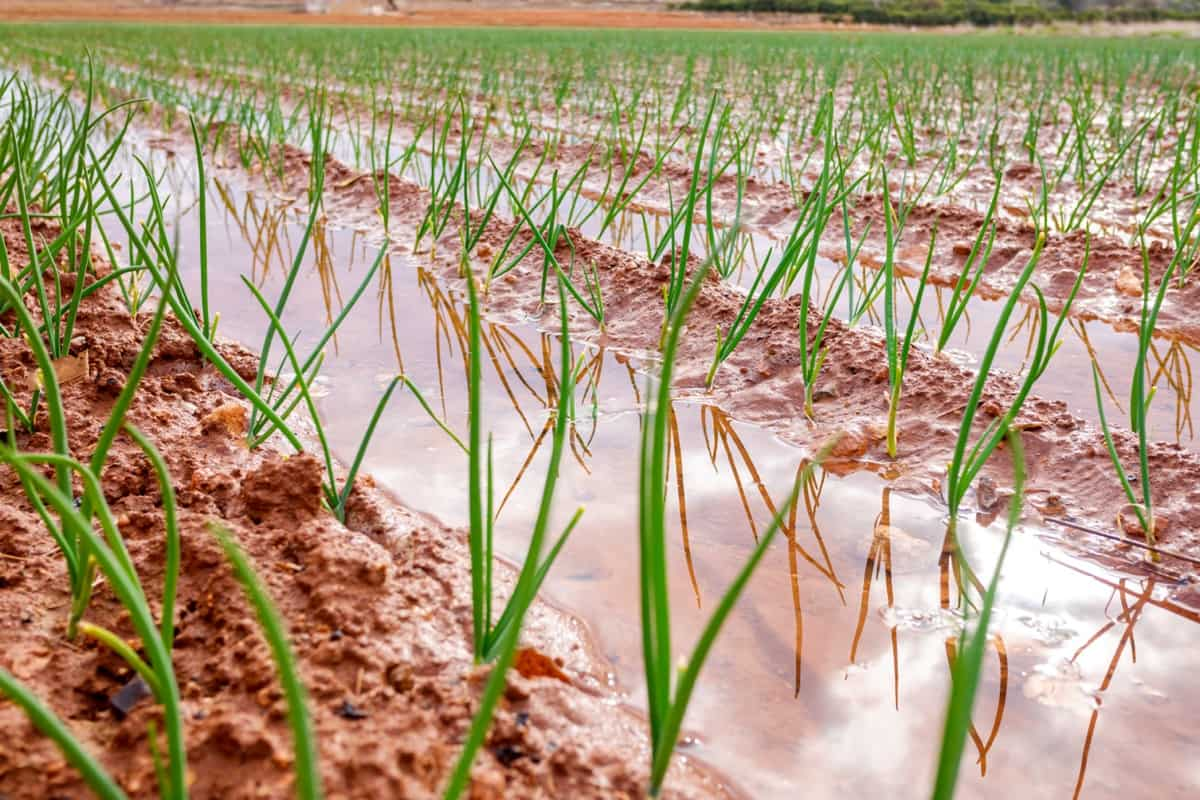Onions are a staple ingredient in many delicious dishes, but their growth can be hindered by a pesky problem known as Onion Downy Mildew. This fungal disease can cause serious damage to Onion crops and drastically reduce yields. Fortunately, many ways exist to prevent and treat Onion Downy Mildew without harmful chemicals. There are various factors to consider when it comes to Onion downy mildew prevention and treatment.

How to Prevent Onion Downy Mildew
Downy Mildew of Onion Symptoms
Onion downy mildew is a fungal disease that mostly affects the leaves of Onion plants. The symptoms of this disease usually start with the yellow spots on the leaves, which later become brown and necrotic. As the disease progresses, you may notice a white or grayish fuzz on the underside of infected leaves. This is caused by spores produced by the fungus that thrives in humid conditions.
The infected Onion plants may also exhibit stunted growth, reduced bulb size and weight, premature death of leaves, and poor yield. These symptoms may change depending on factors such as environmental conditions and the severity of infection. It’s important to note that other diseases or pests can cause similar symptoms to Onion downy mildew. Therefore, it’s crucial to correctly identify this disease before treating it.
The Cause of Onion Downy Mildew
Onion downy mildew is caused by a fungal pathogen. This pathogen thrives in cool and moist conditions, making it more likely to occur during the early stages of Onion growth. The fungus attacks the leaves of Onion plants, causing yellowing and eventual death. The spores of this fungus can survive for several years in soil or on plant debris. These spores germinate and infect young Onion plants through their leaves in favorable conditions.
Poor air circulation around the Onions can also contribute to downy mildew development. This is because humid air accumulates around the plants, creating an ideal environment for fungal growth. In addition, stress factors such as nutrient deficiencies or waterlogging can weaken Onion plants’ resistance to disease and make them more susceptible to infection. Preventing and controlling downy mildew requires proper management practices that reduce moisture around Onions, promote good air circulation, and maintain healthy plant growth.
How the Downy Mildew Disease Spread?
The spread of Downy mildew disease can be attributed to several factors. The most common way it spreads is through wind and water movement. When the spores are released into the air, the wind easily carries them to nearby plants. Another factor that contributes to its spread is poor agricultural practices.
In case you missed it: How to Treat Onion Diseases: Effective Natural, Organic Control Methods

Farmers who do not follow proper crop rotation techniques or practice monoculture farming, where only one type of crop is grown in an area for extended periods, increase the risk of spreading downy mildew disease. In addition, infected seeds and transplants also play a significant role in spreading this disease. Moreover, environmental conditions such as high humidity levels and temperatures between 16-24°C provide favorable conditions for the growth and multiplication of downy mildew spores.
Downy Mildew of Onion Disease Cycle
The downy mildew of the Onion disease cycle is a complex and fascinating process that occurs when the spores of the pathogen land on the Onion plant. These spores need moisture to thrive, so they will germinate if there is enough humidity in the air or water on the leaves. Once germinated, they penetrate through the small pores on the underside of leaves and grow into a mycelium network inside them. This network then produces more spores which disperse to other parts of the plant or onto nearby plants, thus spreading this devastating disease.
These lesions may coalesce as time passes, leading to early leaf death – weakening plants, and reducing bulb size at harvest time. Eventually, as temperatures warm above 15°C during daytime hours with high relative humidity levels (>85%), sporulation can occur from either side surfaces of the leaves, presenting themselves as grey-black fuzzy patches visible to the naked eye. Farmers need to understand how this cycle works because it allows them to make informed decisions about prevention strategies such as crop rotation or chemical control measures like copper-based fungicides.
How to Treat Onion Downy Mildew?
Treating Onion downy mildew is crucial to prevent the spread of this fungal disease. Once you notice the symptoms, acting quickly and taking necessary measures is important. The first step in treating Onion downy mildew is removing infected plants from your garden. This will help prevent further spread of the disease. To control Onion downy mildew, use a fungicide spray recommended for Onions. Apply the spray as directed on the package label and reapply as needed until symptoms disappear.
In addition to using a fungicide spray, ensure your Onion plants have proper air circulation and are not overcrowded. This can help reduce humidity levels which contribute to fungal growth. Proper irrigation techniques can also help prevent and treat Onion downy mildew. Avoid overhead watering, which can increase humidity levels; opt for drip irrigation or soaker hoses. By taking these steps, you can successfully treat Onion downy mildew and protect your crop from further damage.
How To Prevent Onion Downy Mildew?
Prevention is always the best approach when it comes to Onion downy mildew. Look for Onion varieties specifically bred to resist fungal diseases like downy mildew. Don’t plant Onions in the same spot year after year. This can lead to a buildup of soil-borne pathogens, including the fungus responsible for downy mildew. Downy mildew thrives in moist conditions, so ensure your Onions are planted in well-draining soil and avoid overwatering them.
In case you missed it: Common Onion Pests and Diseases: Symptoms, Treatment, and Control

Crowded plants create a humid microclimate that can encourage fungal growth. Make sure you space your Onion plants properly according to their requirements. Fungal spores can easily be spread from contaminated tools and equipment, so clean everything thoroughly before using them in different areas of your garden or on other plants.
Conclusion
Onion downy mildew is a disease that can severely affect the growth and yield of Onions. It’s important to take preventive measures such as choosing resistant varieties, practicing crop rotation, controlling moisture levels, and maintaining good hygiene in your garden or farm. If you notice symptoms of Onion downy mildew, act quickly and apply appropriate treatments like fungicides or organic solutions. You can keep your Onions healthy and thriving all season long with proper care and attention.
- Feed Your Flock for Less: Top 10 Tips to Save on Chicken Feed
- Ultimate Guide to Ossabaw Island Hog: Breeding, Raising, Diet, and Care
- Hatching Answers: The Top 10 Reasons Your Chickens Aren’t Laying Eggs
- Eggs and Economics: Breaking Down the Cost of Raising Backyard Chickens
- Defend Your Greens: Proven Methods to Keep Iguanas Out of Your Garden
- Ultimate Guide to Cinnamon Queen Chicken: A Comprehensive Guide for Beginners
- Ultimate Guide to California Tan Chicken: Breeding, Raising, Diet, Egg-Production and Care
- Ultimate Guide to Marsh Daisy Chicken: Breeding, Raising, Diet, and Care
- 10 Types of Chicken Farming Businesses You Can Start for Profits